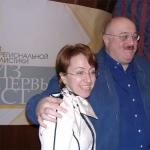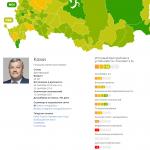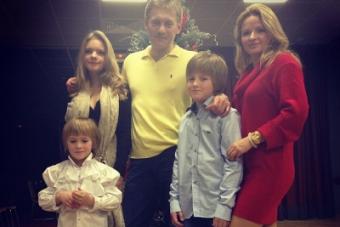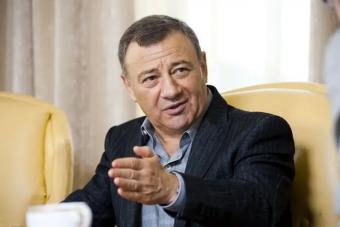Growth and hair loss in children of the first year of life are individual and the complete formation of the hairline ends by 10-11 years. Before this period, various physiological and pathological changes in the skin, hair follicles or rods, metabolic disorders and other causes of hair loss, thinning or hair growth in children are possible.
The first hairs (embryonic fluff or lanugo) appear in a child during its intrauterine development. First, they cover the entire body of the baby, form the original lubricant and gradually peel off. By the time of birth, they remain only on the head.
If a baby is born prematurely, lanugo is sometimes found on the back and other places. In most cases, vellus hair gradually rolls out or falls out by 3-4 months.
Why do babies lose hair and is it dangerous?
In most cases, the processes of loss of embryonic hairs and their replacement with children's hairs occur gradually and do not cause concern for parents - this is a physiological process. Do not worry if, after falling out or rolling out lanugo, the hair does not grow for a certain time or grows slowly, everything in the body of babies is individual. But still, there are conditions when slow hair growth is accompanied by other pathological symptoms, which should not be ignored - it is necessary to urgently contact a specialist and determine the cause of these signs.
The main causes of pathological hair loss or slow hair growth in infants are:

- severe somatic diseases (kidney, liver, various intoxications, connective tissue and blood diseases).
What to do in case of hair loss in the baby?
All these diseases or functional conditions require medical correction or complex treatment:

Parents need to know that as an independent disease, baldness (alopecia) does not develop in children, but is only a symptom of a certain pathological condition or disease.
The following measures are taken to eliminate gneiss:
- 1-1.5 before washing your hair, apply sterilized sunflower, sea buckthorn, olive or burdock oil to the places of accumulation of greasy scales;
- put a flannel hat on your head;
- immediately before bathing, remove the crusts with a soft brush, carefully comb out the gneiss in the place of a large fontanel, if it is open;
- wash your head.
Complete and rapid baldness of a baby with subsequent slow hair growth is often a sign of endocrine pathology in a child or severe somatic diseases that occur with persistent intoxication and a general weakening of the child's body - all these pathologies require immediate diagnosis and adequate treatment.
Prevention of hair loss in newborns
The main preventive measures that prevent hair loss in newborns and infants include:
- proper nutrition for mother and baby;
- timely diagnosis of background diseases and various pathological conditions in a baby, observation of a child of the first year of life by a pediatrician and narrow specialists;
- the use of certified children's products based on natural products for the care of the scalp and hair;
- light head massage, timely removal of seborrheic crusts (gneiss).
pediatrician Sazonova Olga Ivanovna
Article read: 453
The birth of a healthy baby is actually the main life goal of most of the fair sex. Preserving the good health of every part of the body of your baby is the sacred duty of every woman. However, it is important to know that every newborn baby has health problems. You cannot run away from this factor, but it is important to diagnose the “root of evil” in time and cut it down mercilessly.
When baby's hair falls out
Hair loss at such a tender age is not so common, but it does occur. Every caring mother quite rightly begins to sound the alarm on this score if she discovers such defects in her baby. And if you believe the doctors who claim that such a disorder can signal the development of rickets, you can completely give up.
But you can’t do this - first of all, you must identify the essence of the problem in your crumbs and tackle it.
Remember that the period of early development is extremely important for every baby, and therefore you must make every effort required of you to make him healthy and complete.
If your baby has hair falling out on his head, you are probably already anxious and unpleasant, because other mothers rarely complain about such disorders in their children.
Does this mean you are underfeeding or overfeeding your baby?
Or maybe you do not provide him with proper hygiene and daily routine? Or has he been ill with something for a long time, and you weren’t able to help him before, because you are faced with an alarming symptom just now? Do not bother yourself with such questions and be nervous! Remember that the baby needs a calm and confident mother. Therefore, we will try to dispel your fears and help you understand the current problem with its essence.
Causes of baby baldness
The causes of alopecia (baldness or baldness) on the head in babies of one month of age can be very diverse. If your baby has such a manifestation, this is not a reason to worry much. It is possible that the reason for this was functional factors that you can eradicate on your own and without outside help. For example, you should reconsider the choice of shampoos and detergents in which you bathe your child. Here it is better not to skimp and buy goods from foreign manufacturers that are not replete with chemicals, sulfates and other chemicals.
Every newborn loses hair in the first year of his life. The cover on the head of young children is called vellus. The curls growing at the same time are very thin, weak and brittle.
In the process of development, the baby loses them, and in return for the loss, he receives new, stronger, tougher and more resistant to mechanical damage hairs. Therefore, if you see a characteristic rolled fluff on a mattress or pillow, do not worry.
If the prolapse is not too abundant, and there are no related symptoms of any pathology, what happened is a kind of norm.
Why else can a baby's hair fall out?
It happens that this happens for more serious reasons. This is especially true of alopecia areata, or focal alopecia, when smooth-type bald spots appear on the child's head. The skin at the same time looks normal, without injuries, crusts and other mechanical damage.
Alopecia areata can be caused by:
- Autoimmune disorders (failure in the barrier functions of the child's body, when the hair follicles
begin to be systematically destroyed by specific antibodies produced by the body of the baby); - mental trauma;
- Stress (most often a child experiences stress when moving to another place of residence, divorce of parents, changing time zones, and also after undergoing surgical interventions);
- Hormonal imbalance caused by a disorder of the thyroid gland;
- Fungal diseases and ringworm.
In some children, the so-called total alopecia is even observed, when the head is completely bald.
It is also important to be aware of the phenomenon of telogen baldness. It is characterized by such a state of the hair body, in which the follicle does not just fall asleep, but literally dies, falls into something like clinical death. As a result of the loss of this hair, an inactive follicle is left under the skin, which can no longer function as it should.
Such a process in children often develops against the background of an overdose of vitamins, severe stress, general anesthesia (and surgery in general).
Telogen baldness can occur against the background of a schematic treatment of a child with certain medications. It can also be provoked by mechanical trauma to the head. This phenomenon is temporary and self-destructs after the cause is eliminated.
Grandma's tales
Why else does baby hair fall out at 3 months, or any other age? This can occur against the background of injuries to the follicles (hair follicles).
It is important for every parent to know that in babies they are located abnormally close to the surface of the skin, and any, even the most insignificant mechanical damage, can permanently destroy them. This is especially true for shaving. In no case should a child’s head be shaved, as “kind” grandmothers can advise. Previously, this was done with the aim of making the hair grow faster, and also be thick and dense. You must understand that such actions are not only pseudoscientific, but also extremely dangerous. After such an aggressive injury, the follicles cannot be restored, which means that your child is guaranteed alopecia areata for life.
The "harmless" reason
The main functional cause of hair loss in an infant is their banal change, which we have already mentioned earlier.
If from birth to 3 months of life you observe bald spots on your baby’s head, and the hairs themselves often remain on bedding, you should not panic at all. This process only says that the formation of the structure and type of new, "adult" curls is taking place.
Even if you are sure that this is happening, you must carefully and responsibly monitor the condition of your child. Be sure to contact your doctor if you notice any strange manifestations on the part of his health!
And if a month old baby's hair falls out "painless" anyway, mention it to the pediatrician at one of the scheduled checkups.
Hair loss = rickets?
Many pediatricians deliberately frighten young mothers with the fact that diffuse or focal alopecia in a newborn necessarily has a clear relationship with rickets. However, this is not at all the case. Moreover, rickets is much more pronounced and pronounced, and therefore you simply cannot miss its symptoms.
Clinical manifestations of progressive rickets:
- Change in the shape of the head or its strange deformation;
- "Marble" skin;
- increased sweating;
- Breastfeeding for no apparent reason;
- Chronic constipation;
- Restless behavior, constant crying and moodiness;
- Heat;
- Sleep disorders.
Every conscious mother should be especially attentive in autumn and spring, when the baby is rapidly losing calcium and vitamin D resources.
Children are the light in the window, they give joy and happiness. However, all children often get sick and this gives parents a lot of trouble and worries.
Does breast hair fall out?
If your child's hair begins to fall out, there is nothing to panic. The organs and systems of the newborn are not fully formed. The hair of the crumbs is more like fluff, they are easy to damage even when combing.
A child may be born without hair at all, but even if he has a little vegetation on his head, then within a year it will fall out, and stronger and more beautiful hair will appear, which is not so easy to damage.
If the child has whole bald spots, you need to go to the pediatrician and ask him if the baby's hair falls out?
An insidious type of baldness in newborns is alopecia areata, in which the hair falls out in bunches, leaving behind smooth patches on the head. The process is fast and in a few days the child can become completely bald. With this phenomenon, strict medical control and the use of corrective drugs are necessary. This happens due to a malfunction in the immune system, in which the child's antibodies destroy the hair follicles. Doctors also believe that stress, trauma, and malfunctioning of the thyroid gland can be the causes. If you do not provide timely assistance to the child, alopecia areata will move to the second stage and become total, in which the hair will be lost forever.
If there has been an injury to the hair follicle, such as during shaving, the hair may begin to fall out. In no case should a child’s head be shaved, as the hair follicles are too close to the surface of the skin and can be easily injured. Trauma can be not only mechanical, but also chemical. Areas of baldness can appear when various chemicals come into contact with the skin.
Telogen baldness is a phenomenon in which the hair stops growing and falls into a coma. This is due to an overdose of vitamins, medicine, injury or surgery. If you understand the cause and eliminate it, telogen baldness will stop, and the hair will begin to grow normally again.
Another cause of baldness is ringworm. This is a fungal disease in which round, scaly spots appear on the head, on which there is no hair. Treatment in this situation is prescribed by a dermatologist who prescribes antifungal drugs.
During the first three months of life, vellus hair changes to coarser. At this age, the presence of bald spots should not be a concern. The structure of the hair changes, and follicles are just being formed.
Why do babies lose hair? If, in addition to hair loss, a child’s head sweats at night and its shape changes, then you need to go to the doctor, perhaps the baby has rickets. In winter and spring, a child may lack vitamin D and calcium, the lack of these elements leads to such a serious disease as rickets. This disease deforms the spine, bones of the skull and skeleton. If a child is losing hair on the back of his head, he most likely has rickets. Although the cause may be the banal wiping of soft hair on the pillow. In order to understand the true cause of hair loss, it is better to go to the doctor and figure it out.
Emotional outbursts, stress and fear are strong shocks that the fragile child's psyche endures with great difficulty. Sometimes children's hair can fall out from strong experiences.
In order for the hair not to fall out, it is necessary to put on the baby a soft cap at night, which fits snugly to the head.
You need to bathe the baby only with special foams and shampoos that do not cause irritation and allergies. Children's cosmetics should not contain active chemical components. With shampoo, the child is bathed once a week. Baths should be done every day, but at the same time add decoctions of herbs to them.
Hair is formed and improved up to five years. The first hair falls out before three months. In order for everything to be fine, you need to strictly monitor the health of the child, properly feed, carry out hygiene procedures and, if necessary, consult a doctor.
My baby is losing hair on her head, what should I do?
The main cause of hair loss in newborns is their structure. Even if the baby was born with hair, they are wiped off in a month on the sheet. The hair shaft is fully formed only by the age of five, by which time the hair becomes stiff and thick.
Before birth, the child received a large amount of hormones from the mother. After separation, hormones become less, and the body sometimes reacts with hair loss. After adapting to the new conditions of existence, hair growth will resume.
My baby is losing hair on her head, what should I do? First of all, you need to seriously approach the issue of choosing children's cosmetics. Baby shampoo should not contain sodium lauryl sulfate - a substance that forms foam, but accumulates in the body. A child should not be washed with cosmetics intended for adults, as it contains fragrances and preservatives that can cause allergies in a child.
While swimming, the water temperature should not exceed 37 degrees. If there is no special thermometer, you can touch the water with your elbow. With shampoo, you need to wash your hair no more than once a week, but simply with water every time you bathe. Epithelium scales accumulate on the head, which form a crust, so after bathing, you need to brush your head with a special brush, which will get rid of the stratum corneum that interferes with hair growth.
After bathing, you can rinse the baby's skin with a decoction of chamomile, sage or string. If possible, add the decoction directly to the water. Well, if particles of plants remain in the water, this will contribute to the development of the sensory sensations of the child. After bathing, the child should simply be wrapped in a towel for a while and pressed to him. If a crust or seborrheic dermatitis forms on the head, then after bathing the scalp can be lubricated with boiled vegetable oil.
In order for children to feel good, they need to feel love and care from those around them. Adults also need it, but not as acutely as children. When the mother is near, she is calm and affectionate, the child feels comfortable and good, as in the period of intrauterine development.

Hair loss in babies is a fairly common phenomenon. Why this happens and - read in our material.
Newly minted mothers often start to panic when they notice that they have. However, newborn hair loss is completely normal and nothing to worry about. Hair loss in infants often occurs during the first six months of life - this is hair loss in the telogen stage.
A newborn's hormone levels drop immediately after birth, which can lead to the hair she was born with. New moms often lose a lot of hair for the same reason.
If you notice that your child has bald islands on his head, watch how he sits and sleeps. If he always sleeps in the same position or often sits with the back of his head against the back of a child seat, his hair may begin to fall out in this area. Bald islets can also appear if the baby rubs the head against the mattress.
Other causes of hair loss in children
In addition to those described above, there are other causes of hair loss in a child, but they are very rare in infants under 12 months of age.
1.
Bald patches with red, scaly scales may indicate that your child has a fungal infection -.
2.
Physical exposure - for example, tight hairstyles (tails and spikelets) - can lead to hair loss called traction alopecia.
3.
Irregular patches of hair can fall out if the child (now older) constantly twists and pulls the hair. This is called trichotillomania.

4.
If your child develops smooth, rounded, completely bald patches on his head, he may have alopecia areata, a condition that attacks the hair follicles, dramatically slowing down hair growth. This type of hair loss usually appears in isolated areas, although it may well affect all body hair.
5.
Other conditions such as (a thyroid disorder) or hypopituitarism (an underactive pituitary gland) can cause hair loss in a child.
How to stop baby hair loss
All you can do is just wait patiently for your baby to grow new hair.
If your child has bald areas due to staying in one position, try a different way to put him to sleep during the daytime and at night. If you usually put your baby head to one side of the cradle, try putting him to sleep with his head to the other side every other time.
It is also important every day. In this way, you not only give the back of the head a break, but also develop the baby.
Be sure to inform the doctor about hair loss in the baby, especially if it occurs after six months. It is highly likely that there is nothing to worry about and everything is fine, but the doctor may want to conduct a more detailed examination to make sure that there are no other, more serious reasons for hair loss. If, for example, a child has ringworm, he will definitely be prescribed an antifungal agent.
If the doctor suspects that the child has Areata alopecia, you may be referred to a dermatologist. (Many children outgrow the condition without treatment. But older children will need medical attention to stimulate hair growth.)
If there is no hair due to some kind of injury or external influence, you just need to wait and heal the sore spot. (Remember that a child's hair is thinner and more delicate than adult hair, so you need to comb your baby and do her hair carefully).
There are no guarantees, but in most cases, hair loss in a child is temporary. So all you have to do is just wait a bit.
Why is my child completely bald
Many babies seem bald, but if you look closely at their head, you can see pale, short and very thin hairs. This type of "bald state" sometimes lasts until the baby's first birthday. And after that, the period of dashing curls or stylish strands begins.
Many mothers, fearing for the health and condition of their baby, examine his body very closely and often find hair loss in babies with fear. In fact, the very fact of hair loss in newborns practically does not mean anything - in itself this phenomenon is not dangerous and often not caused by anything, but in combination with some other symptoms it can be a sign of a disease. Let's see why the baby's hair falls out and what it might mean.
Baby hair falls out - is it dangerous?
The first hair of the baby is very thin and delicate, resembling fluff. That is why they are often called "vellus" hair. Many mothers should prepare for the fact that the first hair of their crumbs will be very fickle - the hair of babies often falls out on their own and this is absolutely normal. When rubbing the head against a mattress, pillow, mother's hand when breastfeeding, a cap during a walk, the newborn's skin sweats, and thin hairs fall out very easily. Also, the hair of newborns can fall out when combing with a soft comb - there is nothing unnatural in this either.
Usually hair loss in a newborn during the first three months- it is at this time that the child experiences the so-called developmental leap, the hairline is also gradually replaced. Instead of thin "vellus" hair, the baby grows new, stronger and tougher. However, the process of replacing baby hair that has fallen out can be delayed - new hair grows later, up to a year and a half.
So, there is nothing dangerous in the fact that a baby's hair falls out in the first months of life when there are no other symptoms that may indicate to you a possible illness in the child.
Newborn hair falls out - "specialists" scare with rickets
In fact, hair loss in infants can indeed be a sign of the progression of a dangerous disease - rickets. However, if hair loss in newborns is not accompanied by any other symptoms, there is nothing to be afraid of. Associated symptoms of rickets doctors call:
- increased sweating
- refusal to breastfeed
- constant crying
- frequent constipation.
If, in addition to hair loss, the baby has any of these symptoms- See your pediatrician for advice.
Why does newborn hair fall out?
As we have already said, the main cause of hair loss in infants is their structure. Many babies are born already with hair, but they are so thin that they often roll up and fall out even without external influence - combing, but simply from friction, say, on a mattress. In addition, the hair that will appear over time may differ in color. It is not uncommon for a baby to be born a brunette, but in the first few months of life, the color of his hair changed beyond recognition - this is completely normal. The fact is that the hair shaft is fully formed only by the age of five. It is at this age that the baby's hair becomes thicker and tougher.





